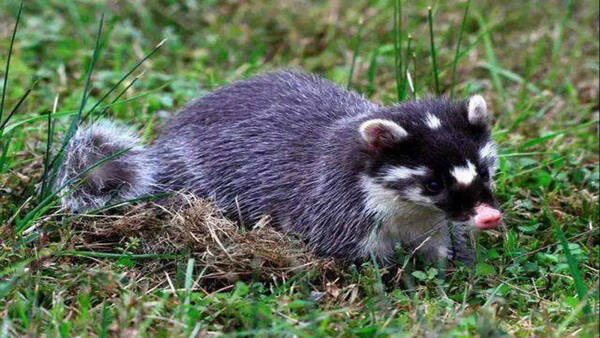Melogale moschata
IUCN
LCBasic Information
Scientific classification
- name:Melogale moschata
- Scientific Name:Melogale moschata,Chinese Ferret-badger,Fish loach, white-nosed civet cat, white-fronted civet cat, mountain badger, piglet civet cat
- Outline:Carnivora
- Family:Suborder Mustelidae Subfamily Genus
Vital signs
- length:31.5-41.7cm
- Weight:1-1.5kg
- lifetime:8-10years
Feature
When walking, the abdomen is almost touching the ground, and the nose is often close to the ground to search for progress.
Distribution and Habitat
Distributed in China, India, Lao People's Democratic Republic, Myanmar, and Vietnam.
In China, it is distributed in Hainan, Guangdong, Guangxi, Guizhou, Yunnan, Sichuan, Anhui, Hubei, Hunan, Jiangsu, Shanghai, Zhejiang, Jiangxi, Fujian, Chongqing, and Taiwan.
The badger lives in forests, shrubs, and grasses in river valleys, gullies, hills, and mountains. It likes to move in low mountain evergreen deciduous and broad-leaved forests below 2,000 meters above sea level, and also lives in mounds, grasslands, and rotten wood piles in farmland areas.
Appearance
The body shape of the ferret badger is between that of the genus Marten and the genus Badger, with a weight of 1-1.5kg and a body length of 315-417mm. The nose is well developed, with hair between the nose pad and the upper lip, the neck is thick and short, the ear shells are short, round and upright, and the eyes are small and prominent. There are 5 toes on the front and rear feet, with thick toe pads, flat and curved claws on the sides, and long front claws, especially the second and third claws, which are suitable for digging life. The back claws are only half the length of the front claws.
The coat color of ferret badgers varies greatly, with the back and outer sides of the limbs being light grayish-brown or yellowish-brown, and dark purple-gray to tan. The color of the head and neck is darker than the back of the body; there is a continuous white or milky white stripe from the back of the head to the back. Vertical lines. There are amorphous white or milky white spots on the fo
Details
The ferret badger (scientific name: Melogale moschata) is known as Chinese Ferret-badger and has 7 subspecies.

Ferret badgers are nocturnal. They come out in pairs after dark and return to their burrows in the early morning. Individual activities and foraging can last until dawn. They usually live in seclusion in caves during the day, and occasionally rest in the bushes around the caves. If disturbed, they dive into the cave. The seasonal changes in the activity of ferret badgers are obvious. In spring and winter, they are often active in forest edges and shrubs on sunny slopes; in summer and autumn, they are more active in forests on shady slopes and among shrubs in river valleys. It likes to forage in dry ditches or streams. It digs for food with its paws and snout, often leaving half-moon-shaped traces of digging in the soil. Its range of activities is small and fixed. It follows a certain path in and out, following the ridges of river valleys. There are obvious "animal trails" left by walking back and forth under the wall or beside the small mountain ridge. The movement is relatively slow. When walking, the abdomen is almost touching the ground. It often searches forward with its nose close to the ground.
Weasel badgers burrow in stone caves and rock crevices, and are also good at digging holes. The entrance of the cave is round, usually with only one opening. It opens in steep mountains and places with thick vegetation. The caves are simple, with straight or curved paths. Some caves where weasel badgers live have a foul smell. The smell is extremely strong, and there are often long black strips of feces on both sides of the hole, 6.0-6.5cm long and 0.6-0.8cm in diameter. The feces are often mixed with hair, bones and other residues.
The ferret badger is omnivorous. It feeds on earthworms, shrimps, crabs, insects, loaches, small fish, frogs and rodent-shaped animals, as well as fruits and roots of plants. In spring, they feed mainly on insects, small fish, frogs and plant roots; in summer, they feed mainly on insects, Lepidoptera, moths and frogs; in autumn, when food is abundant, in addition to small animals, they also feed on hawthorns, potatoes and other Wild fruits; from late autumn to winter, the food is dominated by invertebrates, and the fruits and roots of plants also increase accordingly.
Ferret badgers breed once a year. They go into heat and mate in March. Most of them occur in the same group. Males and females mate with each other without fighting for mates. After mating, the males and females still forage and live together. They give birth in caves from May to June, giving birth to 2-4 cubs per litter, and occasionally giving birth to 1 cub. The mother nurse her cubs for 2 months. After that, the mother leaves the cave and separates from the cubs. The cubs reach sexual maturity one year later.
The distribution of ferret badger populations is not fragmented. This species is generally relatively common in its habitat. From 1991 to 1993, 238 ferret badgers were found in Taiwan; in 2003, a survey in southeastern China showed that although an average of 40 ferret badgers were captured in an area of 16km² per year, this species was still very abundant. Its population development trend is unknown.
Listed in the 2008 Red List of Endangered Species of the World Conservation Union (IUCN) ver 3.1 - Least Concern (LC).
Protect wild animals and eliminate wild game.
Maintaining ecological balance is everyone’s responsibility!








